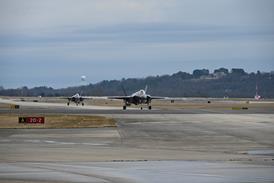US National Transportation Safety Board issues alert that no amount of accumulation is safe for take-off
Pilots are being warned that minute amounts of ice on a wing upper surface can cause severe aerodynamic and control penalties. The US National Transportation Safety Board (NTSB) has issued the alert as it investigates the November fatal crash of a Bombardier Challenger 604 on take-off from Montrose, Colorado.
The NTSB says atmospheric conditions conducive to upper wing surface ice accumulation existed at the time of the Montrose accident, and that the aircraft had not been de-iced. The alert also follows the December publication of safety recommendations stemming from an NTSB review of 26 Cessna 208 Caravan icing-related accidents and incidents from 1987 to 2003.
"The bottom line is that pilots should be aware that no amount of snow, ice or frost accumulation on the wing upper surface can be considered safe for take-off," says the NTSB. The board urges pre-flight tactile inspections of the wing upper surface and liberal use of de-icing.
The alert cites several take-off accidents in which upper wing ice was a factor, including the January 2002 crash of a Challenger 604 at Birmingham, UK; the October 2001 crash of a Cessna 208 at Dillingham, Alaska; the March 1992 crash of a USAir Fokker F28 at New York LaGuardia; and the February 1991 crash of a Ryan International Airlines McDonnell DC-9-15 at Cleveland, Ohio.
Investigating the USAir F28 crash, the NTSB found that wing upper surface roughness caused by 1-2mm diameter particles at a density of one per square centimetre can cause lift losses of 22-33%. It concluded that visual inspection is unlikely to detect the minimal contamination sufficient to degrade the aerodynamic performance of any aircraft.
In its review of Cessna 208 icing accidents, the NSTB concluded 10 of the 26 events involved inadequate removal of ice that had accumulated while the aircraft was on the ground. While continuing its review of the Caravan's design and certification, the NTSB has made recommendations to the US Federal Aviation Administration, including:
* seasonal training for ground de-icing and flight into icing conditions to be conducted annually;
* operational strategies and guidance materials to be developed and incorporated into operator manuals and training programmes;
* visual and tactile inspection of the wing and horizontal stabiliser leading edges and upper surfaces to be conducted before flight, where temperatures are conducive to frost or ground icing.
The Flight Safety Foundation is now urging the FAA to drop existing dangerous icing guidelines revealed by the UK Air Accident Investigation Branch in its Birmingham accident report (Flight International, 14-20 December).
GRAHAM WARWICK / WASHINGTON DC
Source: Flight International























